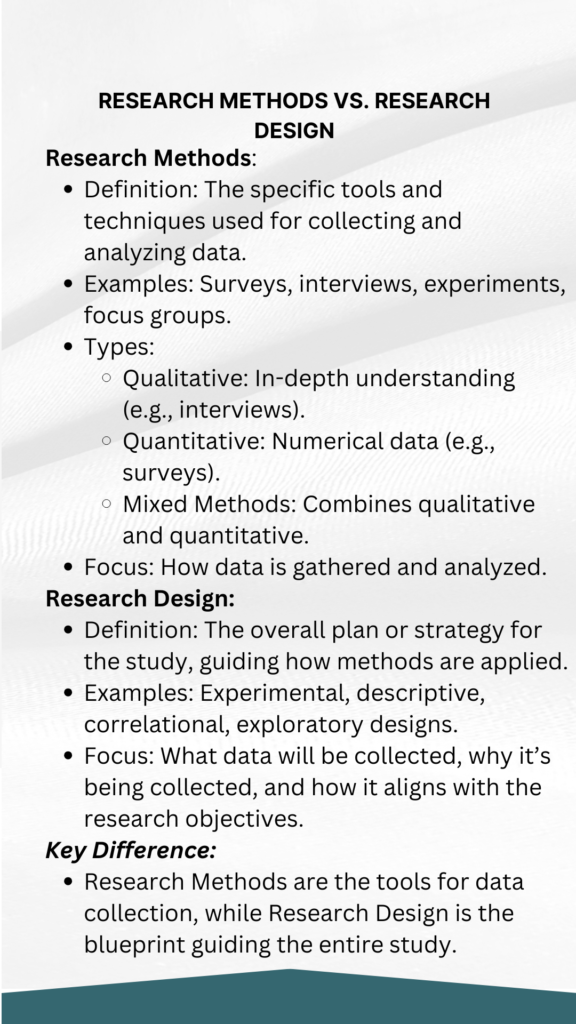In academic and scientific research, research methods and research design are two essential components that play major yet interconnected roles in shaping the success of any academic study.
While they are often used interchangeably, these terms refer to different aspects of the research process. Research methods focus on the specific techniques and tools used to collect and analyze data, such as surveys, experiments, or interviews.
On the other hand, research design refers to the overall strategy and structure of the study, outlining how and when these methods will be applied to ensure the research questions are answered effectively.
Understanding the differences between research methods and designs is crucial for conducting meaningful and well-structured research, as it helps clarify the steps required to gather valid and reliable results.
What is a research method?
A research method refers to the techniques or procedures researchers use to collect, analyze, and interpret data to investigate a research question or hypothesis. These methods can vary widely depending on the nature of the research study and the type of data required. Examples of research methods include surveys, experiments, interviews, observations, content analysis, and statistical analysis, among others.
Each method has its strengths and limitations, and researchers select the most appropriate method based on the research objectives, the characteristics of the study population, and practical considerations such as time and resources. Research methods are essential tools that enable researchers to gather empirical evidence and draw meaningful conclusions from their studies.
What is a research design?
Research design refers to the overall plan, structure, and strategy formulated by researchers to guide the process of conducting a research study. It encompasses the framework within which data collection and analysis occur.
A research design outlines the blueprint for how the research will be carried out, including key elements such as the type of study (e.g., descriptive, exploratory, experimental), the sampling strategy, the timing and sequence of data collection, and the data analysis methods.
The choice of research design is influenced by factors such as the research objectives, the nature of the research questions, the characteristics of the study population, and practical considerations such as time and resources.
A well-developed research design ensures the study is conducted systematically and rigorously, ultimately leading to valid and reliable research findings.
What is the difference between Research Design and Research Method?
Research design encompasses the overarching plan and structure of a research study, detailing the framework within which data collection and analysis occur, including the type of study, sampling strategy, and sequencing of procedures.
In contrast, research methods refer to the specific techniques or procedures employed within the research design to collect, analyze, and interpret data, such as surveys, experiments, interviews, or content analysis.
While research design provides the blueprint for the study’s organization and execution, research methods serve as the practical tools for gathering empirical evidence and testing hypotheses, with both components being crucial for successfully implementing a research project.
|
Research Methods |
Research Design |
| Definition |
Specific techniques or procedures used to collect data, such as surveys, experiments, interviews, etc. |
Overall plan or strategy for conducting research, including the choice of methods, data collection, and analysis. |
| Focus |
Focuses on how data is gathered or collected. |
Focuses on the overall structure and organization of the research study. |
| Purpose |
Determines how data will be obtained and analyzed to address research questions or hypotheses. |
Guides the entire research process, ensuring the study is conducted systematically and logically. |
| Examples |
Surveys, experiments, interviews, observations, case studies, etc. |
Experimental design, survey design, case study design, correlational design, etc. |
| Flexibility |
It can vary depending on the specific needs of the research study. Different methods may be used within the same research design. |
Provides a framework within which specific methods are chosen and applied. |
| Influence on Study |
The choice of method can directly impact the type and quality of data collected. |
Determines the study’s overall structure and organization, influencing the research findings’ validity and reliability. |
Types of Research Design
- Descriptive Research Design: This type of design describes the characteristics or behaviours of a population or phenomenon. It does not involve manipulating or controlling variables but focuses on observing and documenting existing conditions or relationships.
- Exploratory Research Design: Exploratory research is conducted when little is known about a topic or phenomenon, aiming to understand better or generate hypotheses for further investigation. It often involves qualitative methods such as interviews, focus groups, or observations.
- Correlational Research Design: Correlational research examines the relationship between two or more variables without manipulating them. It seeks to determine whether changes in one variable are associated with changes in another, but it does not establish causation.
- Experimental Research Design: Experimental research involves manipulating one or more variables to observe the effect on another variable while controlling for extraneous factors. This design allows researchers to establish cause-and-effect relationships and is often considered the gold standard for scientific research.
- Quasi-Experimental Research Design: Quasi-experimental research resembles experimental research but lacks random assignment to treatment groups. This design is used when random assignment is not feasible or ethical, yet researchers still want to compare different groups or conditions.
- Longitudinal Research Design: Longitudinal research involves studying the same group of individuals over an extended period to observe changes or trends. This design is valuable for examining developmental trajectories, changes over time, or the long-term effects of interventions.
- Cross-Sectional Research Design: Cross-sectional research collects data from a sample of individuals at a single point in time. It provides a snapshot of the population or phenomenon at that moment but does not capture changes over time.
- Mixed-Methods Research Design: Mixed-methods research combines qualitative and quantitative approaches within a single study. It allows researchers to gather a more comprehensive understanding of a research problem by triangulating multiple data sources.

Factors to consider when choosing a method
Several factors should be considered when choosing a research method to ensure the technique is appropriate for the research objectives and context. Some key factors include:
- Research Questions: The research questions guide the selection of the research method. Consider whether the technique will allow you to address the research questions and test hypotheses effectively.
- Research Objectives: Clearly define the study’s objectives and determine how the chosen method aligns with these objectives. Consider whether the technique will provide the necessary data to achieve the desired outcomes.
- Nature of the Phenomenon: Consider the characteristics of the phenomenon being studied. Is it a complex social process, a biological phenomenon, or a psychological construct? Different methods may be more suitable for exploring other types of phenomena.
- Research Design: The overall research design influences the choice of research method. Consider whether the technique aligns with the study’s design, whether it is experimental, descriptive, correlational, or qualitative.
- Data Collection: Evaluate the feasibility and practicality of the data collection process associated with the method. Consider factors such as the availability of resources, time constraints, access to participants, and ethical considerations.
- Data Analysis: Consider how the data collected will be analyzed and whether the chosen method will produce data that can be effectively analyzed to answer the research questions.
- Validity and Reliability: Assess the validity and reliability of the method. Will the technique produce valid and reliable results that accurately reflect the phenomenon being studied?
- Ethical Considerations: Ensure the chosen method adheres to moral principles and guidelines. Consider whether the method respects the rights and dignity of participants and minimizes potential harm or risks.
- Researcher Expertise: Consider the skills and expertise of the researcher or research team. Choose a method that aligns with their knowledge, training, and experience.
- Theoretical Framework: Theoretical considerations can also influence the choice of research method. Consider whether the technique is consistent with the study’s theoretical framework and allows testing theoretical propositions.
Purpose of Research Design
- Guidance: Imagine research design as your trusty map on a journey. Just like a map helps you navigate unfamiliar terrain, research design guides researchers through the maze of their study. It lays out the path, showing where to start, which turns to take, and where the destination lies.
- Clarity: Research design is like a flashlight cutting through the darkness of uncertainty. It illuminates the way forward, helping researchers define their goals, questions, and methods clearly. With research design in hand, researchers can see exactly what needs to be done, avoiding confusion.
- Alignment: Think of research design as the compass keeping you on track. It ensures that every step you take syncs with your ultimate destination – answering your research questions. By aligning objectives with methods, research design ensures researchers focus on what truly matters.
- Validity and Reliability: Research design acts as the sturdy foundation of a building. Just as a solid foundation ensures the stability of a structure, a well-designed study enhances the validity and reliability of research findings. It guards against shaky ground, minimizing errors and biases that could undermine the survey’s integrity.
- Efficiency: Research design is like a well-oiled machine, making every cog turn smoothly. It helps researchers maximize their resources – time, money, and manpower. By providing a clear plan of action, research design eliminates guesswork, streamlining the research process for maximum efficiency.
- Ethical Considerations: Research design is the ethical compass guiding researchers through moral dilemmas. It ensures that researchers conduct their studies with integrity and respect for human dignity. Like a moral compass, research design helps researchers navigate tricky ethical terrain, ensuring that the rights and well-being of participants are protected.
- Flexibility: Research design is like a sailing ship navigating stormy seas. It provides a sturdy framework yet allows for adaptation to changing conditions. Researchers can adjust their course as needed, responding to unexpected challenges while staying true to the spirit of their study.
Read more Abstract of a Research Paper
Final Thought
Distinguishing between research methods and research design is fundamental for any researcher. While research methods pertain to the specific techniques and tools employed in data collection and analysis, research design sets the overarching framework and structure of the study.
Embracing this discrepancy ensures that researchers can navigate their studies effectively, writing methodologically sound inquiries while staying attuned to the broader conceptualization of their research.
By understanding how research methods and design intersect and complement each other, researchers can embark on scientifically robust endeavours that can yield significant insights in their respective fields.









 Evan John
Evan John